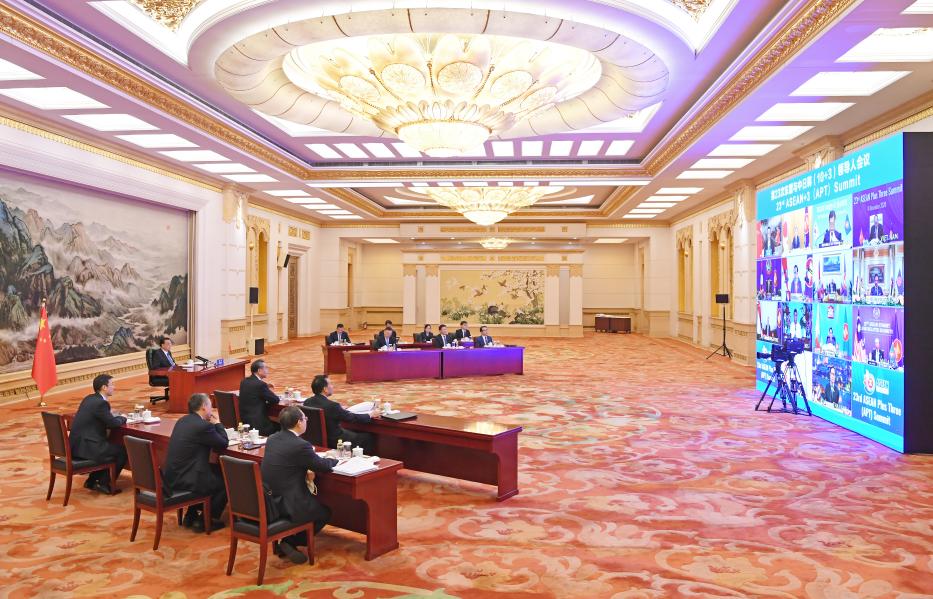 Chinese Premier Li Keqiang attends the 23rd leaders' meeting of the Association of Southeast Asian Nations (ASEAN) plus China, Japan and the Republic of Korea (ROK) (ASEAN Plus Three), which is held via video link, at the Great Hall of the People in Beijing, capital of China, Nov. 14, 2020. (Xinhua/Liu Weibing)
Chinese Premier Li Keqiang attends the 23rd leaders' meeting of the Association of Southeast Asian Nations (ASEAN) plus China, Japan and the Republic of Korea (ROK) (ASEAN Plus Three), which is held via video link, at the Great Hall of the People in Beijing, capital of China, Nov. 14, 2020. (Xinhua/Liu Weibing)
BEIJING, Nov. 15 (Xinhua) -- As a series of virtual meetings among the leaders of the Association of Southeast Asian Nations (ASEAN), China, Japan and the Republic of Korea (ROK) drew to a close on Sunday, the prospect of even more vibrant cooperation is emerging. That would enable the region to manage the coronavirus pandemic more effectively and boost economic recovery.
CONCERTED ACTION AGAINST COVID-19
In times of adversity -- two financial crises, major natural disasters, and the onslaught of COVID-19 -- East Asian countries have always stood together and looked out for each other.
The Special ASEAN Plus Three (China-Japan-ROK) Summit on COVID-19 was held in April. The active implementation of the summit's outcomes has bolstered the region's response to the virus, leading to a comparatively low infection rate.
As the world is facing a second wave of infections, hopes are being laid on the development of vaccines. The ASEAN Regional Reserve of Medical Supplies (RRMS) was officially launched this week during the 37th ASEAN Summit.
China has pledged to work with other parties to establish the ASEAN Plus Three Reserve of Medical Supplies for Public Health Emergencies and enhance its coordination with the RRMS.
What's also worth noting is that four Chinese vaccines are currently in Phase III clinical trials, and China is collaborating with a number of countries on the research and development, production and procurement of vaccines. China has joined COVAX, a United Nations-backed global facility to ensure effective and equitable access to COVID-19 vaccines, and is ready to advance international vaccine cooperation.
China has also promised to take into account the needs of countries in the region and work toward the accessibility and affordability of vaccines.
"East Asian countries supported each other with medical supplies and shared relevant experience and technologies, which proved through facts and actions that multilateralism, solidarity and cooperation are the most effective ways to deal with the pandemic," Cao Jing, deputy Secretary-General of the Trilateral Cooperation Secretariat (TCS), told Xinhua in an interview early this week.

Chinese Premier Li Keqiang attends the 23rd leaders' meeting of the Association of Southeast Asian Nations (ASEAN) plus China, Japan and the Republic of Korea (ROK) (ASEAN Plus Three), which is held via video link, at the Great Hall of the People in Beijing, capital of China, Nov. 14, 2020. (Xinhua/Zhang Ling)
FASTER REGIONAL ECONOMIC RECOVERY ON THE HORIZON
Over the past 50 years and more, a well-connected and sophisticated industrial system that draws on the strengths of different parties has gradually taken shape in East Asia, playing an important role in spurring the economic growth of countries in the region and enhancing regional competitiveness.
A report recapping the achievements of the China-ASEAN Free Trade Area (CAFTA) was released this week as the two sides celebrate the 10th anniversary of CAFTA's full establishment.
On Sunday, the Regional Comprehensive Economic Partnership (RCEP) agreement was signed among its 15 participating countries, launching the world's biggest free trade bloc.
Participating countries include the 10 member countries of ASEAN (Brunei, Cambodia, Indonesia, Laos, Malaysia, Myanmar, the Philippines, Singapore, Thailand, and Vietnam) and China, Japan, ROK, Australia and New Zealand.
The World Bank Group said in a report published in June that growth in East Asia and Pacific is projected to fall to 0.5 percent in 2020 and it is the only region that could see growth this year, while the International Monetary Fund forecast that China would be the only major economy to post positive growth in 2020.
China's growth, given its role in the region, "is having positive spillovers, for the region and for commodity prices and for, broadly, participants in the global value chains that China is a big part of," Jonathan D. Ostry, acting director of the IMF's Asia and Pacific Department, said during a virtual news conference in October following the release of the IMF's Regional Economic Outlook.
Despite disruptions caused by COVID-19, China's trade with ASEAN, Japan and the ROK all held basically steady in the first three quarters.
In the January-September period, China-ASEAN trade reached 481.81 billion U.S. dollars, up 5 percent year-on-year, making ASEAN China's largest trading partner. China's industry-wide foreign direct investment in ASEAN topped 10.72 billion dollars, jumping 76.6 percent year-on-year.
Countries in the region are working on the establishment of a network of "fast tracks" and "green lanes" in a phased manner to facilitate the flows of people and goods.
The importance of the digital economy has been further uncovered in the context of COVID-19. ASEAN has adopted the ASEAN Digital Masterplan 2025, and China is formulating a national plan on IT application for the 14th Five-Year Plan period (2021-2025). And this year has been designated as the China-ASEAN Year of Digital Economy Cooperation.
On this basis, the two sides are working to synergize digital development strategies and boost infrastructure development and transformation in the digital field. Cooperation on innovation in areas such as e-commerce, smart cities, big data and 5G is expected to intensify. ■



